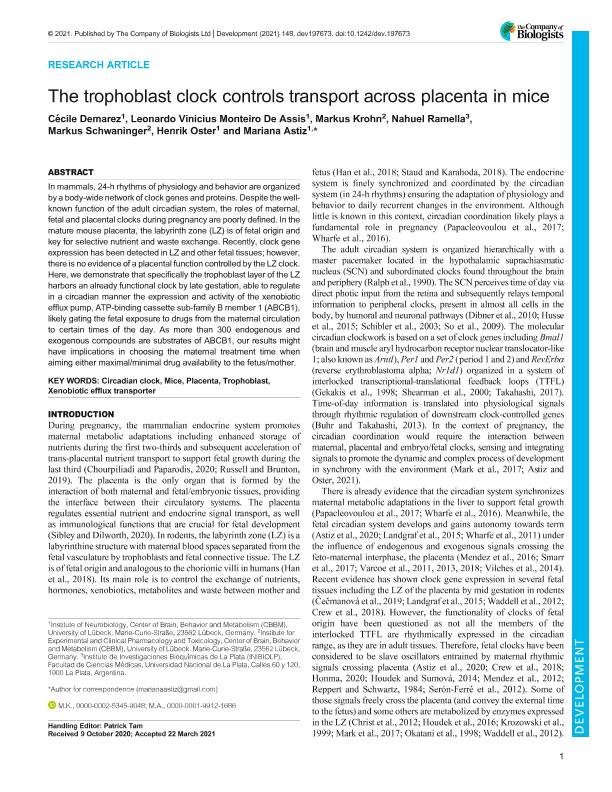Mostrar el registro sencillo del ítem
dc.contributor.author
Demarez, Cécile
dc.contributor.author
de Assis, Leonardo Vinicius Monteiro
dc.contributor.author
Krohn, Markus
dc.contributor.author
Ramella, Nahuel

dc.contributor.author
Schwaninger, Markus
dc.contributor.author
Oster, Henrik
dc.contributor.author
Astiz, Mariana

dc.date.available
2022-10-28T13:26:12Z
dc.date.issued
2021-04
dc.identifier.citation
Demarez, Cécile; de Assis, Leonardo Vinicius Monteiro; Krohn, Markus; Ramella, Nahuel; Schwaninger, Markus; et al.; The trophoblast clock controls transport across placenta in mice; Company of Biologists; Development; 148; 8; 4-2021; 1-11
dc.identifier.issn
0950-1991
dc.identifier.uri
http://hdl.handle.net/11336/175315
dc.description.abstract
In mammals, 24-h rhythms of physiology and behavior are organized by a body-wide network of clock genes and proteins. Despite the well-known function of the adult circadian system, the roles of maternal, fetal and placental clocks during pregnancy are poorly defined. In the mature mouse placenta, the labyrinth zone (LZ) is of fetal origin and key for selective nutrient and waste exchange. Recently, clock gene expression has been detected in LZ and other fetal tissues; however, there is no evidence of a placental function controlled by the LZ clock. Here, we demonstrate that specifically the trophoblast layer of the LZ harbors an already functional clock by late gestation, able to regulate in a circadian manner the expression and activity of the xenobiotic efflux pump, ATP-binding cassette sub-family B member 1 (ABCB1), likely gating the fetal exposure to drugs from the maternal circulation to certain times of the day. As more than 300 endogenous and exogenous compounds are substrates of ABCB1, our results might have implications in choosing the maternal treatment time when aiming either maximal/minimal drug availability to the fetus/mother.
dc.format
application/pdf
dc.language.iso
eng
dc.publisher
Company of Biologists

dc.rights
info:eu-repo/semantics/openAccess
dc.rights.uri
https://creativecommons.org/licenses/by-nc-sa/2.5/ar/
dc.subject
CIRCADIAN CLOCK
dc.subject
MICE
dc.subject
PLACENTA
dc.subject
TROPHOBLAST
dc.subject
XENOBIOTIC EFFLUX TRANSPORTER
dc.subject.classification
Biología del Desarrollo

dc.subject.classification
Ciencias Biológicas

dc.subject.classification
CIENCIAS NATURALES Y EXACTAS

dc.title
The trophoblast clock controls transport across placenta in mice
dc.type
info:eu-repo/semantics/article
dc.type
info:ar-repo/semantics/artículo
dc.type
info:eu-repo/semantics/publishedVersion
dc.date.updated
2022-09-20T18:39:29Z
dc.journal.volume
148
dc.journal.number
8
dc.journal.pagination
1-11
dc.journal.pais
Reino Unido

dc.journal.ciudad
Cambridge
dc.description.fil
Fil: Demarez, Cécile. Universität Zu Lübeck; Alemania
dc.description.fil
Fil: de Assis, Leonardo Vinicius Monteiro. Universität Zu Lübeck; Alemania
dc.description.fil
Fil: Krohn, Markus. Universität Zu Lübeck; Alemania
dc.description.fil
Fil: Ramella, Nahuel. Consejo Nacional de Investigaciones Científicas y Técnicas. Centro Científico Tecnológico Conicet - La Plata. Instituto de Investigaciones Bioquímicas de La Plata "Prof. Dr. Rodolfo R. Brenner". Universidad Nacional de la Plata. Facultad de Ciencias Médicas. Instituto de Investigaciones Bioquímicas de La Plata "Prof. Dr. Rodolfo R. Brenner"; Argentina
dc.description.fil
Fil: Schwaninger, Markus. Universität Zu Lübeck; Alemania
dc.description.fil
Fil: Oster, Henrik. Universität Zu Lübeck; Alemania
dc.description.fil
Fil: Astiz, Mariana. Universität Zu Lübeck; Alemania. Consejo Nacional de Investigaciones Científicas y Técnicas; Argentina
dc.journal.title
Development

dc.relation.alternativeid
info:eu-repo/semantics/altIdentifier/doi/http://dx.doi.org/10.1242/dev.197673
dc.relation.alternativeid
info:eu-repo/semantics/altIdentifier/url/https://journals.biologists.com/dev/article/148/8/dev197673/256558/The-trophoblast-clock-controls-transport-across
Archivos asociados
